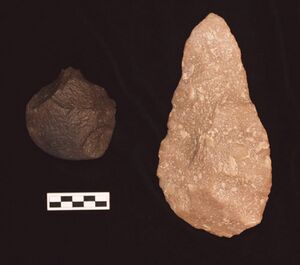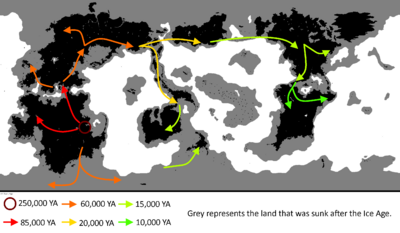Prehistorical Era
This article is a work in progress. Any information here may not be final as changes are often made to make way for improvements or expansion of lore-wise information about Gentu. Please comment on this article's talk page to share your input, comments and questions. Note: To contribute to this article, contact User:Philimania. |

| Part of a series on the |
| History of Gentu and Gentish human history (Hodiernus epoch) |
|---|
| ↑ before Homo (Septun epoch) |
|
Prehistorical Era (one-era three-age system) |
|
| Ancient Era |
|
| Antiquity Era |
|
| Middle Era |
|
| Modern Era |
|
| ↓ Future |
The Prehistorical Era, also known as pre-literary history, is the period of Gentish human history between the Ice Age when one branch of the Septentropithecines developed skills in stone working c. 3.3 million years ago and the beginning of recorded history with the invention of writing systems in Plevapotamia. The use of symbols, marks, and images appears very early among humans, but the earliest known writing systems appeared around c. 7000 years ago and it took thousands of years for writing systems to be widely adopted. In some human cultures, writing systems were not used until the nineteenth century and, in a few, are not even used until the present.
Enasan in Plevapotamia, Quan, and Creek were the first civilizations to develop their own scripts and to keep historical records; this took place already during the early Bronze Age. Neighboring civilizations were the first to follow. The one-era three-age system of division of prehistory into the Vetuslithic Age, followed by the Novalithic Age and Cuprulithic Age.
The period when a culture is written about by others, but has not developed its own writing system is often known as the protohistory of the culture. By definition, there are no written records from human prehistory, so dating of prehistoric materials is crucial. Clear techniques for dating were not well-developed until the nineteenth century.
Vetuslithic Age

"Vetuslithic" means "Old Stone Age", and begins with the first use of stone tools.
The early part of the Vetuslithic is called the Lower Vetuslithic, which predates Homo captiosus, beginning with Homo rectus (and related species) and the earliest stone tools, dated to around 2.5 million years ago. Evidence of control of fire by early humans during the Lower Vetuslithic is uncertain and has at best limited scholarly support. The most widely accepted claim is that the Homo rectus made fires between 790,000 and 690,000 years ago in a site at XXX. The use of fire enabled early humans to cook food, provide warmth, and have a light source at night.

Early Homo captiosus originated some 250,000 years ago, ushering in the Middle Vetuslithic. Anatomic changes indicating modern language capacity also arise during the Middle Vetuslithic. During the Middle Vetuslithic, there is the first definitive evidence of human use of fire. Sites in XXX have charred bone and wood that have been dated to 61,000 years ago. The systematic burial of the dead, music, early art, and the use of increasingly sophisticated multi-part tools are highlights of the Middle Vetuslithic.
Throughout the Vetuslithic, humans generally lived as nomadic hunter-gatherers. Hunter-gatherer societies tended to be very small and egalitarian, although hunter-gatherer societies with abundant resources or advanced food-storage techniques sometimes developed sedentary lifestyles with complex social structures such as chiefdoms, and social stratification. Long-distance contacts may have been established, as in the case of Ancient Auralian "roads".
Great Migration
Early Homo captiosus remained in its birthplace, Central Naphtora until somewhere around 85,000 years ago when humans migrated to North Naphtora and crossed the Naphtoran land bridge shortly after into Oranland thus beginning the Great Migration. By 60,000 years ago, Humans had migrated to most of Hesterath and the sunken continent of Subarctica, and would have entered Alabon around the same time. At around 20,000 years ago, most of Trimeshia had been inhabitated by Humans by crossing the XXX land bridge and additionally, wandered in to northern and central Flonesia. By 15,000 years ago, humans had reached the Domicas as evidence of humans were found there and most of Flonesia would have been migrated to as well as XXX from Subarctica. At around 10,000 years ago, South Domica would have been inhabitated marking the end of the Vetuslithic and the beginning of the Novalithic
Novalithic Age

The Novalithic Age, or "New Stone Age" (from the XXX nova, 'new', and lithos, 'stone'), was a period in the development of human technology between the Vetuslithic and Cuprulithic Age.
The Novalithic period began at the end of the Great Migration, some 10,000 years ago, and ended with the introduction metallurgy in Plevapotamia. But, in some areas such as North Naphtora, metallurgy was already underway by the end of the Great Migration, and there the Novalithic is short and poorly defined.
The Novalithic also saw the end of the last Ice Age with the retreat of glaciers and the Great Sinking around 7,000 BCE. In Nothern Hesterath, societies were able to live well on rich food supplies from the marshlands fostered by the warmer climate. Such conditions produced distinctive human behaviours that are preserved in the material record, such as the Dordon and Hextern cultures.
Remains from this period are few and far between, often limited to middens. In forested areas, the first signs of deforestation have been found when more space was needed for agriculture which was first developed some time around 9,000 BCE in Northern Naphtora.
Early farming was limited to a narrow range of plants, both wild and domesticated, which included wheat, millet and spelt, and the keeping of dogs, sheep, and goats. By about 6,900–6,400 BCE, it included domesticated cattle and pigs, the establishment of permanently or seasonally inhabited settlements, and the use of pottery. The late Novalithic saw the development of early villages, agriculture, animal domestication, tools, and the onset of the earliest recorded incidents of warfare. The Novalithic ended when metal tools became widespread (in the Cuprulithic Age or Bronze Age; or, in some geographical regions, in the Iron Age).
Settlements became more permanent with some having circular houses with single rooms made of mudbrick. Settlements might have a surrounding stone wall to keep domesticated animals in and protect the inhabitants from other tribes. Later settlements had rectangular mud-brick houses where the family lived together in single or multiple rooms. Burial findings suggest an ancestor cult where people preserved skulls of the dead. The XXX culture may have created the earliest system of writing. The large temple complexes of XXX are notable for their gigantic structures. Although some late Hesterath societies formed complex stratified chiefdoms or even states, states evolved in Hesterath only with the rise of metallurgy, and most Novalithic societies on the whole were relatively simple and egalitarian. Most clothing appears to have been made of animal skins, as indicated by finds of large numbers of bone and antler pins which are ideal for fastening leather. Wool cloth and linen might have become available during the later Novalithic, as suggested by finds of perforated stones that (depending on size) may have served as spindle whorls or loom weights.
Cuprulithic Age
In archaeology, the "Cuprulithic", or "Copper Age" refers to a transitional period where early copper metallurgy appeared in Plevapotamia. During this period, some weapons and tools were made of copper. This period was still largely Novalithic in character. It is a phase of the Bronze Age before it was discovered that adding tin to copper formed the harder bronze. The Copper Age was originally defined as a transition between the Novalithic and the Bronze Age. However, because it is characterized by the use of metals, the Copper Age is considered a part of the Bronze Age rather than the Novalithic Age.
An archaeological site in XXX contains the oldest securely dated evidence of copper making at high temperature, from 7,500 years ago. The find in XXX extends the known record of copper smelting by about 800 years, and suggests that copper smelting may have been invented independently in separate parts of Hesterath, North Domica, and Naphtora at that time, rather than spreading from a single source. The emergence of metallurgy may have occurred first in North Naphtora, where it gave rise to the Bronze Age in the 4th millennium BCE (the traditional view), although finds from the Late Hextern culture in Oranland have now been securely dated to slightly earlier than those of North Naphtora. XXX Valley contains evidence of copper mining 9,000 to 7,000 years ago. The process of transition from Novalithic to Cuprulithic in the XXX is characterized in archaeological stone tool assemblages by a decline in high quality raw material procurement and use.
Transition into ancient history
The Bronze Age is the earliest age of the Ancient Era, in which some humanity had reached the end of the Prehistorical Era, by the introduction of written records. Soon after the appearance of writing, people started creating texts including written accounts of events and records of administrative matters.
While copper is a common ore, deposits of tin are rare in Oranland and Hesterath, and often had to be traded or carried considerable distances from Naphtora, stimulating the creation of extensive trading routes. In many areas as far apart as XXX and XXX, the valuable new material was used for weapons but for a long time apparently not available for agricultural tools. Much of it seems to have been hoarded by social elites, and sometimes deposited in extravagant quantities, from XXX ritual bronzes and XXX copper hoards to Oranland hoards of unused axe-heads.
By the end of the Bronze Age, large states, which are often called empires, had arisen in places such as Northern Naphtora, and Plevapotamia, all of them literate.
Timeline
All dates are approximate and conjectural, obtained through research in the fields of anthropology, archaeology, genetics, geology, or linguistics. They are all subject to revision due to new discoveries or improved calculations. BP stands for "Before Present (2000)." BCE stands for Before Common Era".
Vetuslithic
Lower Vetuslithic
- c. 2.8 million BP – Genus Homo appears.
- c. 2.5 million BP – Evidence of early human tools.
- c. 1.5 million BP – Homo rectus wanders out of Naphtora.
- c. 840,000–810,000 BP – The raft is invented.
- c. 790,000-690,000 BP – Control of fire by early humans.
- c. 700,000 BP – Earliest evidence of the existence of hearths and shelters.
- c. 600,000 BP – Hunting-gathering.
- c. 300,000–30,000 BP – Extinction of Homo Rectus in Oranland.
Middle Vetuslithic
- c. 250,000 BP – Anatomically modern humans (Homo captiosus) appear in Naphtora, one of whose characteristics is a lack of significant body hair compared to other primates.
- c. 170,000–83,000 BP – Invention of clothing.
- c. 117,000 BP – The Inaye supereruption occurs, wiping out roughly one-third of the modern human population.
- c. 85,000 BP – Humans migrate out of East Naphtora. In the next millennias, descendants from this population migrate to Hesterath, the Oranland, Flonesia, Trimeshia, and the Domicas.
- c. 80,000–50,000? BP – Behavioral modernity, by this point including language and sophisticated cognition.
Upper Vetuslithic
- c. 45,000 BP / 43,000 BCE – Beginnings of Hextern culture in northern Hesterath.
- c. 40,000 BP / 38,000 BCE – First human settlement in the northern half of Flonesia.
- c. 32,000 BP / 30,000 BCE – Beginnings of Dordon culture, exemplified by the cave paintings in caves of Oranland.
- c. 30,000 BP / 28,000 BCE – Humans reach Trimeshia; Bow and arrow invented
- c. 30,000–14,000 BP – Early dogs are domesticated.
- c. 28,000–20,000 BP – Harpoons, needles, nets, and saws invented in Oranland.
- c. 26,000 BP / 24,000 BCE – People around the world use fibers to make baby-carriers, clothes, bags, baskets, and nets.
- c. 25,000 BP / 23,000 BCE – A settlement consisting of huts built of rocks and mammoth bones is founded near what is now XXX in the XXX. This is the oldest human permanent settlement that has been found by archaeologists.
- c. 23,000 BP / 21,000 BCE – Small-scale trial cultivation of plants in Plevapotamia, a hunter-gatherers' sedentary camp on the shore of the Exore river.
- c. 15,000 BP – Humans reach North Domica via the XXX land bridge.
- c. 14,800 BP / 12,800 BCE – The Humid Period begins in North Naphtora. The region that would later become the Meglimos desert is wet and fertile, and the aquifers are full.
- c. 12,500 to 8,500 BCE – Norwich culture: a culture of sedentary hunter-gatherers who may have cultivated Rye in Eastern Oranland.
- c. 10,000 BP – End of the Great Migration.
- c. 7,400–7,200 BCE – Figs are cultivated in the early Novalithic village Salum in Northern Naphtora. The find predates the domestication of wheat, barley, and legumes, and may thus be the first known instance of agriculture.
Novalithic Age
- c. 7,000 BCE – The last Ice Age ends with the retreat of glaciers and the Great Sinking.
- c. 6,000 BCE – Circles of T-shaped stone pillars erected at XXX in XXX.
- c. 6,000 BCE – In Plevapotamia, cultivation of barley and wheat begins. At first they are used for beer, gruel, and soup, eventually for bread. In early agriculture at this time the planting stick is used, but it is replaced by a primitive plow in subsequent centuries. Around this time, a round stone tower, now preserved at about 8.5 meters high and 8.5 meters in diameter is built in XXX.
- c. 7,000–6,000 BCE – Homo validus dies out in Paloa.
Cuprulithic Age
- c. 4,950 BCE – Settled communites in Plevapotamia.
- c. 4,800 BCE – Rice is cultivated in Qiuhua.
- c. 4,600 BCE – Maize is cultivated in Central Domica.
- c. 4,500 BCE – The humid period ends in Naphtora.
- c. 4,400 BCE – Farming in the Sub-Exore region appears.
- c. 3,950 BCE – First evidence of agriculture on the Chainilen.
- c. 3,800-3400 BCE – Itshezu statues in South Naphtora.
- c. 3,740 BCE – Domestication of the horse in Juksia.
- c. 3,700 BCE – Early writing, known as Proto-Grafi, appears in Plevapotamia, and records begin to be kept. According to the majority of specialists, the first Plevapotamian writing (actually still pictographic proto-writing at this stage) was a tool for record-keeping that had little connection to the spoken language.
- c. 3600 BCE – The wheel and plow is invented in Plevapotamia.
- c. 3538 BCE – Silk is first produced in Qiuhua.
- c. 3400 BCE – Linen is produced in Plevapotamia.
- c. 3350 BCE – The Shan dynasty is believed to have formed.
- c. 3240 BCE – Calidum city-states emerge.
- c. 3240 BCE – The sail is invented in the Calidum.
- c. 3215 BCE – Earliest evidence of complex writing in Plevapotamia.
- c. 3200 BCE – Hieroglyphs in the Calidum.
- c. 3180 BCE – Unification of the Calidum. The Calidum Kingdom is established.
- c. 3150 BCE – Creek city-states emerge.
- c. 3100 BCE – Mutamarma supereruption
- c. 3060 BCE – Renhull culture appears in eastern Oranland.
By region
TBA


